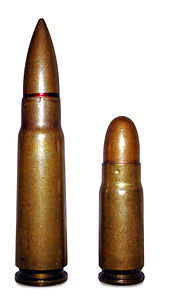Full jacket bullet
A full metal jacket bullet is a type of projectile for weapons with a bullet diameter of up to 20 mm with a copper , tombac or iron jacket around a hard lead core . The jacket protects the barrel of rifles from the abrasion of the softer lead and also prevents the lead core from deforming or even splintering when it hits a soft target such as a human or animal body.
The full jacket bullet was invented in 1882 by Swiss Colonel Eduard Rubin when he was working for the Eidgenössische Munitionsfabrik, which developed ammunition for the Swiss military.
Since the Hague Land Warfare Regulations forbid the use of projectiles that cause unnecessary suffering (such as dum-dum projectiles ), only full -jacket projectiles are used in the military that also have better penetration against cover or ballistic protective clothing.
In the case of hunting and police use, on the one hand, high penetration power and bullets are not desired because of the risk to bystanders, on the other hand, the target should be stopped as soon as possible ( man-stopping effect ). Therefore, full jacketed bullets are no longer used for these purposes, but mostly special dismantling cartridges.
A full metal jacket bullet will not disintegrate within a soft target, even if it hits bone; then it deforms, but does not "enlarge" as much as a partially jacketed or hollow point bullet . With long bullets , especially with small calibers such as 5.56 × 45 mm NATO , it can happen that the bullets roll over at certain shooting distances in the body and break in the process.
The EFMJ ( E xpanding F ull M etal J acket) is a special form. It is a projectile that has a soft tip in front of the lead core. B. has rubber. When hitting a target, the tip gives way and the jacket becomes extremely deformed. This construction attempts to combine the ballistic properties of a full-jacketed bullet on the one hand and the man-stopping effect of a hollow-point bullet on the other.
See also
literature
- Beat Kneubuehl : Bullets . Volume 1: Ballistics, accuracy, mode of action . 2nd Edition. Motorbuch Verlag, Stuttgart 1998, ISBN 3-7276-7119-X .
- Beat Kneubuehl: Bullets . Volume 2: Ballistics, effectiveness, measurement technology . Motorbuch Verlag et al., Stuttgart et al. 2004, ISBN 3-613-30501-1 .
- Beat Kneubuehl (eds.), Robin Coupland, Markus Rothschild , Michael Thali: Wundballistik. Basics and Applications . 3rd completely revised and expanded edition. Springer Medizin Verlag, Heidelberg, 2008, ISBN 978-3-540-79008-2 .
- Manfred R. Rosenberger: weapons and ammunition used by the police . Motorbuch Verlag, Stuttgart 2002, ISBN 3-613-02246-X .
- David Harding (Ed.): Weapons Encyclopedia. From hand ax to cruise missile . 2nd Edition. Motorbuch Verlag, Stuttgart 1995, ISBN 3-613-01488-2 .

